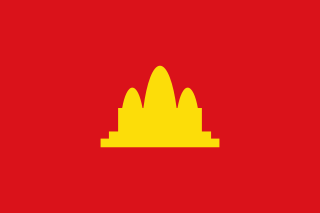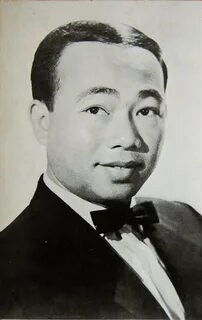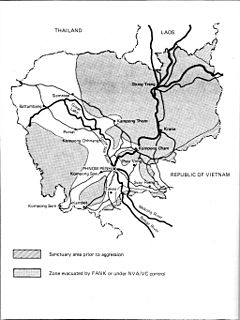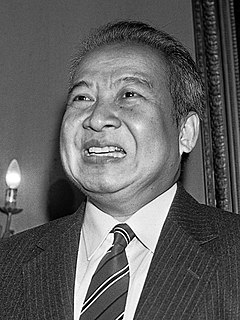The history of Cambodia, a country in mainland Southeast Asia, can be traced back to at least the 5th millennium BCE. Detailed records of a political structure on the territory of what is now Cambodia first appear in Chinese annals in reference to Funan, a polity that encompassed the southernmost part of the Indochinese peninsula during the 1st to 6th centuries. Centered at the lower Mekong, Funan is noted as the oldest regional Hindu culture, which suggests prolonged socio-economic interaction with maritime trading partners of the Indosphere in the west. By the 6th century a civilisation, called Chenla or Zhenla in Chinese annals, firmly replaced Funan, as it controlled larger, more undulating areas of Indochina and maintained more than a singular centre of power.

The Khmer Rouge was the name popularly given to the followers of the Communist Party of Kampuchea (CPK) and by extension to the regime through which the CPK ruled in Cambodia between 1975 and 1979. The name had originally been used in the 1950s by Norodom Sihanouk as a blanket term for the Cambodian left.

Pol Pot was a Cambodian revolutionary and politician who served as the general secretary of the Communist Party of Kampuchea from 1963 to 1981. Ideologically a Marxist–Leninist and Khmer nationalist, he led the Khmer Rouge group from 1963 until 1997. From 1976 to 1979, he served as the Prime Minister of Democratic Kampuchea.

Phnom Penh, formerly known as Krong Chaktomuk or Krong Chaktomuk Serimongkul, is the capital and most populous city in Cambodia. Phnom Penh has been the national capital since French colonization of Cambodia, and has grown to become the nation's economic, industrial, and cultural center.

Marshal Lon Nol was a Cambodian politician and general who served as Prime Minister twice, as well as serving repeatedly as Defense Minister. He led the military coup of 1970 against Prince Norodom Sihanouk and became the self-proclaimed President of the U.S.-backed Khmer Republic, ruling until 1975. He was the founder and leader of the short-lived Social Republican Party, and commander-in-chief of the Khmer National Armed Forces. After the Khmer Rouge took power, Lon Nol fled to the United States, and remained there until his death in 1985.

The Cambodian Civil War was a military conflict that pitted the forces of the Communist Party of Kampuchea and their allies the Democratic Republic of Vietnam and the Viet Cong against the government forces of the Kingdom of Cambodia and, after October 1970, the Khmer Republic, which were supported by the United States (U.S.) and the Republic of Vietnam.

Sinn Sisamouth was an influential and highly prolific Cambodian singer-songwriter from the 1950s to the 1970s.

The Cambodia national football team is the national team of the Kingdom of Cambodia and is controlled by the Football Federation of Cambodia (FFC). It was known as the Khmer Republic national football team from 1970 to 1975. It finished fourth in the 1972 Asian Cup. The team was founded in 1933 and joined FIFA's ranks in 1953. One of Cambodia's best players was Hok Sochetra. Earlier in the decade he was considered one of the top 2 strikers in South East Asia along with Kiatisuk Senamuang from Thailand. In 1997, Hok Sochetra won the best player award in Southeast Asia – the Golden Ball from Sanyo.
The Cambodian coup of 1970 refers to the removal of the Cambodian Head of State, Prince Norodom Sihanouk, after a vote in the National Assembly on 18 March 1970. Emergency powers were subsequently invoked by the Prime Minister Lon Nol, who became effective head of state, and led ultimately to the proclamation of the Khmer Republic later that year. It is generally seen as a turning point in the Cambodian Civil War. No longer a monarchy, Cambodia was semi-officially called "État du Cambodge" in the intervening six months after the coup, until the republic was proclaimed.

Operation Menu was the codename of a covert United States Strategic Air Command (SAC) bombing campaign conducted in eastern Cambodia from 18 March 1969 until 26 May 1970 as part of both the Vietnam War and the Cambodian Civil War. The targets of these attacks were sanctuaries and Base Areas of the People's Army of Vietnam and forces of the Viet Cong (NLF), which utilized them for resupply, training, and resting between campaigns across the border in the Republic of Vietnam. The impact of the bombing campaign on the Khmer Rouge guerrillas, the PAVN, and Cambodian civilians in the bombed areas is disputed by historians.

The Cambodian Campaign was a series of military operations conducted in eastern Cambodia during 1970 by the United States and the Republic of Vietnam as an extension of the Vietnam War and the Cambodian Civil War. The invasions were a policy of President Richard Nixon; 13 major operations were conducted by the Army of the Republic of Vietnam (ARVN) between 29 April and 22 July and by US forces between 1 May and 30 June.

Operation Chenla II or Chenla Two was a major military operation conducted by the Khmer National Armed Forces (FANK) during the Cambodian Civil War from 20 August until 3 December 1971.

Operation Patio was a covert aerial interdiction effort conducted by the U.S. Seventh Air Force in Cambodia from 24–29 April 1970 during the Vietnam War. It served as a tactical adjunct to the heavier B-52 Stratofortress bombing missions being carried out in Operation Menu.
Operation Freedom Deal was a United States Seventh Air Force interdiction and close air support campaign waged in Cambodia between 19 May 1970 and 15 August 1973, as an expansion of the Vietnam War, as well as the Cambodian Civil War. Launched by Richard Nixon as a follow-up to the earlier ground invasion during the Cambodian Campaign, the initial targets of the operation were the base areas and border sanctuaries of the People's Army of Vietnam (PAVN) and the Viet Cong (VC). As time went on most of the bombing was carried out to support the Cambodian government of Lon Nol in its struggle against the communist Khmer Rouge. The area in which the bombing took place was expanded to include most of the eastern one-half of Cambodia. The bombing was extremely controversial, and led the US Congress to pass the War Powers Resolution.

The Ministry of Foreign Affairs and International Cooperation is the government ministry responsible for representing Cambodia to the international community. The ministry oversees the foreign relations of Cambodia, maintains diplomatic missions in other countries, and provides visa services.

The Song of the Khmer Republic was the national anthem of Khmer Republic from 1970 to 1975. The song is often attributed to groups of students, led by Hang Thun Hak, at the Royal University of Fine Arts in Phenom Penh, but academic sources say it was written and composed by the Buddhist monk activist Khieu Chum, a student of Hem Chieu. The song was adopted as the national anthem of the newly founded Khmer Republic on 9 October 1970 after the overthrow of the monarchy. After the end of the Republic due to the Khmer Rouge victory in 1975, the song ceased to be the national anthem and was officially replaced in 1976 by the Khmer Rouge anthem "Victorious 17th of April".















